
Ducati Diavel Service Manual: Starter motor
Power: 0.7 Kw/12 v
Direction of rotation: counter clockwise viewed from power take-off side.
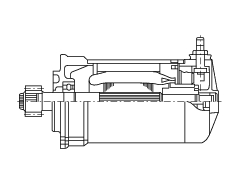
The starter motor is highly compact and reliable and therefore rarely gives any type of problem. In case of troubles, ensure that the starter motor cable terminal is properly tightened under the nut and shows no oxidation. If the terminal is properly tightened and free from corrosion, remove the starter motor and test it under no-load conditions (no load applied to the shaft). Secure the starter motor to a test bench, making sure you do not damage the casing. Use a fully charged 12 v battery for the test. Use battery-motor connection cables which are no longer than 70 cm and with the same cross-section as the cable on the motorcycle itself. Connect the negative terminal of the battery to an unpainted area of the starter motor casing and the positive terminal to its electrical terminal. The shaft of the starter motor should rotate freely and at high speed. Take care not to short-circuit the two cables connected to the battery.
Removing the starter motor
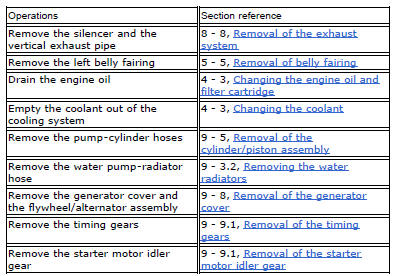
Remove the fixing screw (1) and, if necessary, the insert (2).
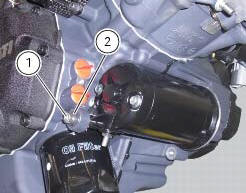
Unscrew the fixing screws (3): the lower screw (3) fixes also the ground cable (6). Collect the toothed washer (7) and the washer (8).
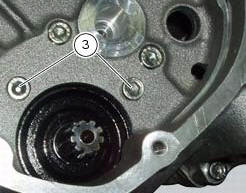
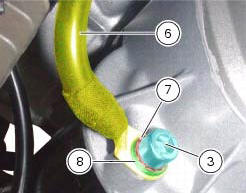
Note
The starter motor retaining screws are assembled with threadlocker.
Slide out the starter motor and gasket (5).
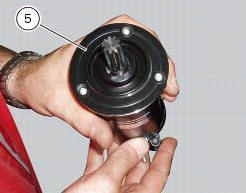
Refitting the starter motor
Inspect the condition of the gasket (5) and renew if necessary.
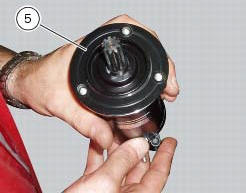
Position the gasket (5) and the starter motor on the crankcase. Start the retaining screws (3) with recommended threadlocker; the lower one (3) with the ground cable (6), the toothed washer (7) and the washer (8). Tighten the retaining screws (3) to a torque of 10 nm (min. 9 Nm - max. 11 Nm) (sect. 3 - 3, Engine torque settings).
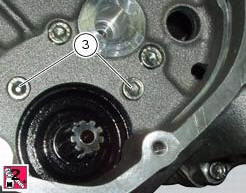
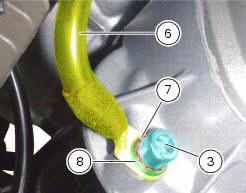
Locate the insert (2) (if removed) in the crankcase half, hand tighten the fixing screw (1) and tighten it to a torque of 10 nm +/- 10% (sect. 3 - 3, Frame torque settings).
Place the starter motor/solenoid starter cable (4) and tighten the retaining nut to a torque of 5 nm +/- 10% (sect. 3 - 3, Frame torque settings).
Important
Fill the cap with protective grease before fitting it on the starter motor.
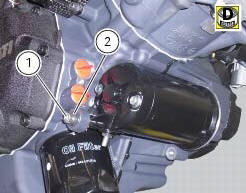

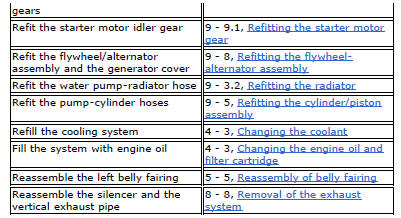
 Electric starting system
Electric starting system
Note
The references of the elements listed below are those of the "wiring
diagram", sect. 6 -1.
Electric starting system
The key components of the electric starting system are a solenoid (6) and ...
 Solenoid starter
Solenoid starter
Remove the protection cover (a).
Undo the screws (2), taking care to collect the spring washers (3).
Remove the starter motor-solenoid cable (4) and the solenoid-battery cable (5).
Remo ...
Other materials:
Guided diagnosis
Note
The on-screen icons used during this procedure are explained in a table at
the end of this section.
The dds diagnosis instrument guides the operator step-by-step through the
various diagnostic procedures,
providing descriptions and documentation for motorcycle components, wiring
diagra ...
Adjusting the clutch lever and front brake lever
The clutch lever (1) is fitted with a span adjuster (2) which serves to alter
the distance of the lever from the handlebar.
The lever distance can be adjusted through 10 clicks of the dial (2). Turn
clockwise to increase lever distance. Turn the
adjuster counter clockwise to decrease lever d ...
Refitting the gear selector lever
Position the gearbox drum selector fork in the centre of the gear rollers.
Position the gear selector lever (21) together with control shaft, spring and
plate into the chain-side crankcase half.
Insert the screws (18) and (20) with the spacer (19).
Temporarily fit gear change lever (or a ...